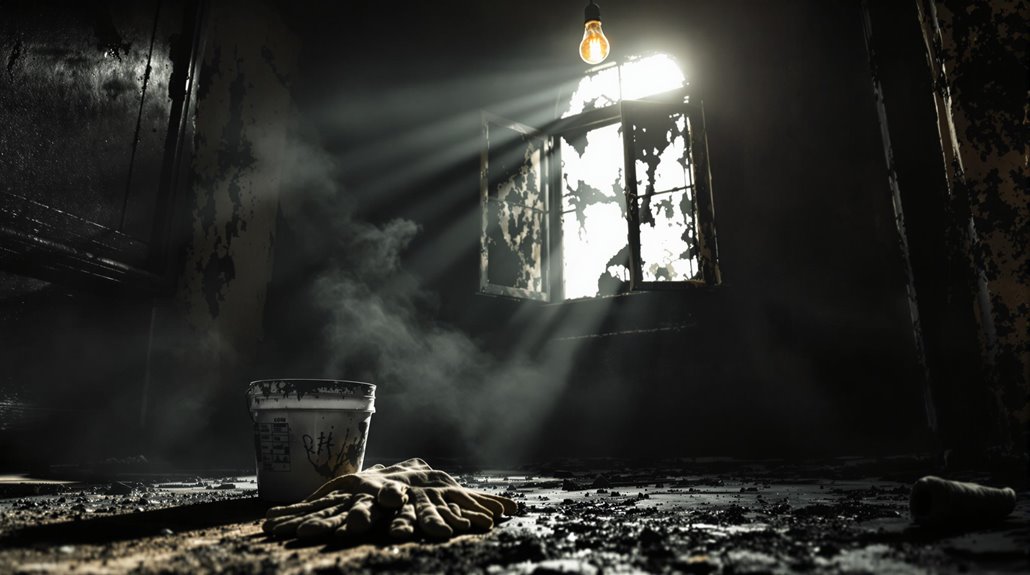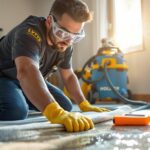After fire damage, you need to avoid certain mistakes to guarantee a smoother recovery. Don't delay action; swift intervention helps prevent further damage from soot, smoke, and moisture. Avoid DIY cleaning, as it can worsen hidden issues. Always document damage thoroughly for insurance claims. Take safety seriously—turn off utilities and wear protective gear. Additionally, don't overlook water damage or signs of structural integrity loss. Each of these missteps can complicate your restoration. By understanding these pitfalls, you can make educated choices and pave the way for effective recovery strategies. There's much more to reflect on for your next steps.
Key Takeaways
- Delay in documenting damage can complicate insurance claims; promptly take photos and create a detailed loss list.
- Attempting DIY cleanup may overlook hidden damage and increase health risks; engage professionals with specialized equipment instead.
- Neglecting to notify your insurance company quickly can violate policy terms; ensure timely communication and keep detailed records.
- Ignoring safety measures, such as turning off utilities, can lead to accidents; always prioritize safety during restoration.
- Failing to assess structural integrity may lead to further damage; seek professional inspections to identify and address hidden hazards.
Delaying Action
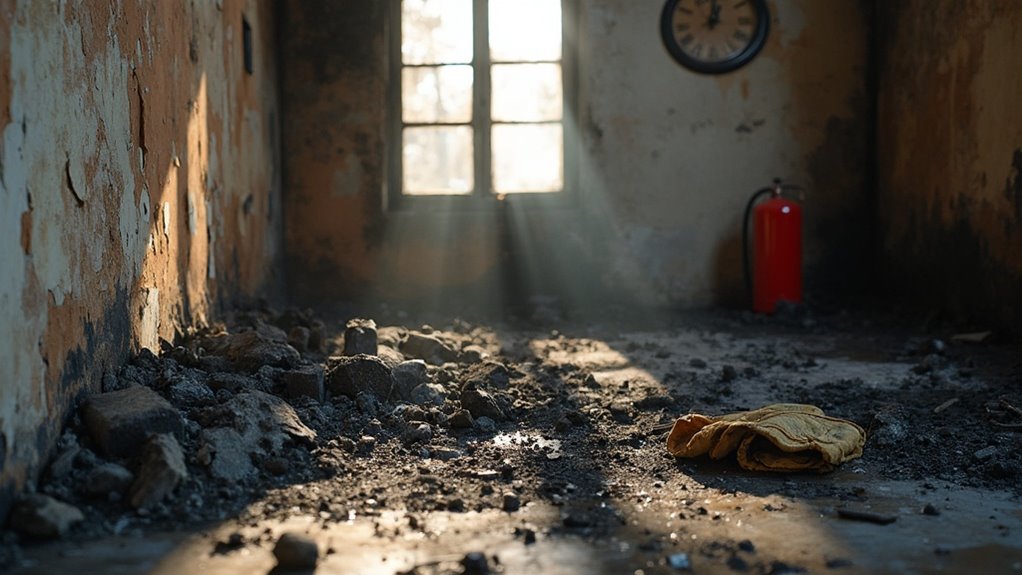
After a fire, time is of the essence, and delaying action can have dire consequences for your property and health. Your fire response must be swift, as every moment that passes allows smoke and soot to infiltrate surfaces, leading to deeper, more persistent damage. This isn't just about aesthetics; acidic smoke particles can corrode materials, and soot can create a stubborn residue that's especially challenging to remove from porous items like drywall and furniture.
Furthermore, if water from firefighting efforts is left unaddressed, it can trigger mold growth and further compromise your building's structural integrity. You'll want to conduct a thorough damage assessment immediately to identify potential hazards, as structural weaknesses can escalate quickly, risking collapse. Rapid cleanup is essential to minimize health risks and restore safety, as lingering smoke and water from firefighting can create new issues if not addressed promptly.
Delaying action not only complicates the cleanup process but also raises costs appreciably. By acting promptly, you can mitigate extensive repairs and protect the health of occupants from hazardous conditions. Remember, timely intervention leads to faster claims processing and minimizes business downtime, ultimately saving you money and stress in the long run. In addition, engaging with licensed and certified technicians ensures that the remediation process adheres to the best practices for effective recovery.
Attempting DIY Cleaning
Attempting DIY cleaning after a fire can seem tempting, but it often leads to more problems than solutions. Without specialized equipment and knowledge, you risk missing hidden damage and using ineffective cleaning agents that may worsen the situation. Prioritizing professional help not only guarantees a thorough restoration but additionally safeguards your health and property. Furthermore, certified technicians are equipped to handle advanced fire damage restoration techniques, ensuring that all aspects of the damage are addressed effectively.
Risks of DIY Methods
Fire damage can leave behind a complex web of challenges that often tempt homeowners to tackle restoration through DIY methods. Nevertheless, this approach can lead to significant risks. One of the major DIY misconceptions is underestimating the extent of damage. Many homeowners overlook hidden issues such as structural compromises or smoke damage, which can worsen over time if not properly addressed.
Furthermore, a lack of specialized knowledge can lead you to use incorrect cleaning agents, causing further harm to surfaces and materials. Restoration myths suggest that simple cleaning techniques suffice, but the reality is far more complex. Each type of fire affects materials differently, requiring tailored approaches for effective restoration.
Health and safety hazards also loom large. DIY attempts may expose you to toxic substances, including soot and volatile compounds, leading to respiratory issues and skin irritation. In addition, inadequate restoration can increase the risk of electrical fires or structural collapse, complicating insurance claims and potentially leading to legal complications.
Need for Specialized Equipment
When faced with the aftermath of a fire, using specialized equipment is indispensable for effective cleanup and restoration. Attempting DIY cleaning with inadequate tools can result in further damage and safety hazards. It's imperative to recognize that specialized tools, designed specifically for fire damage, can make a significant difference in restoring your property safely.
Consider these specialized tools for your restoration efforts:
- Fire damage sponges for dry cleaning surfaces without water.
- Industrial dehumidifiers to prevent mold growth by removing excess moisture.
- Truck mount carpet cleaners for effective removal of soot and smoke from carpets.
- Air scrubbers to deodorize and purify the air by eliminating contaminants.
- HEPA vacuums for removing fine particulate matter from the environment.
Moreover, proper equipment maintenance is crucial to guarantee safety and efficiency. Using the wrong tools can push soot deeper into surfaces or create harmful chemical reactions. Prioritize using advanced technology to detect hidden damage and eliminate lingering odors. By investing in specialized equipment, you protect your health and the integrity of your home during restoration.
Ignoring Odor Removal
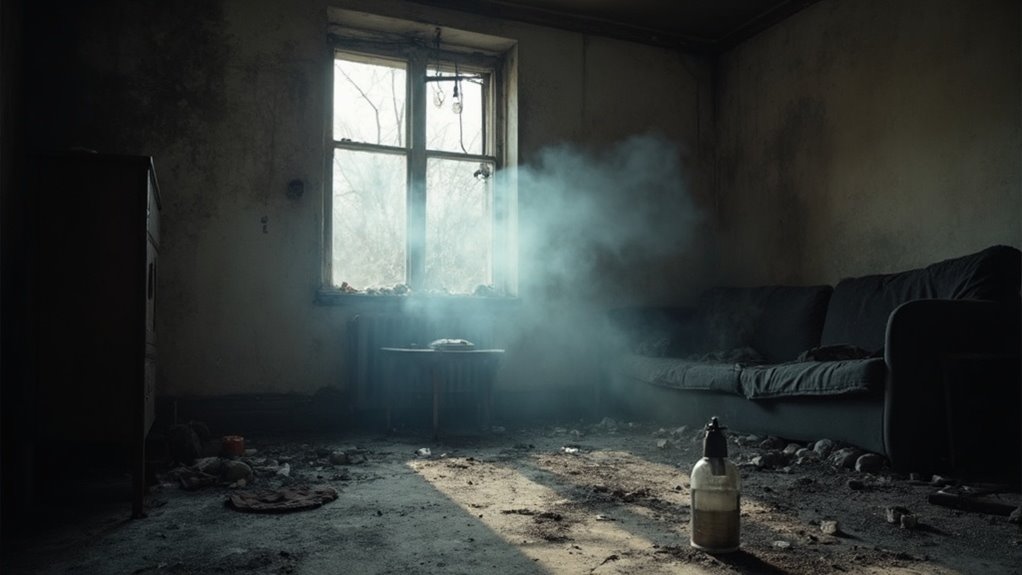
Ignoring odor removal after fire damage can pose serious health risks, as lingering smells often indicate harmful smoke particles still present in your home. Relying solely on DIY methods may not adequately address these issues, making professional removal techniques vital for a safe environment. Thorough cleaning of all affected surfaces and hidden areas is important to guarantee your living space is healthy and odor-free.
Health Risks of Odors
After a fire, the lingering odors of smoke and soot pose significant health risks that shouldn't be overlooked. Ignoring odor removal can lead to various health consequences that jeopardize your well-being. Inhaled particles from soot can cause serious respiratory issues and long-term exposure may increase your risk of lung cancer. Moreover, volatile organic compounds (VOCs) released from smoke can contribute to persistent health problems.
To effectively address these risks, consider the following:
- Breathing Issues: Inhaling soot can aggravate asthma and bronchitis.
- Toxin Exposure: Smoke contains harmful irritants that worsen respiratory conditions.
- Indoor Air Quality: Smoke odors degrade air quality, making your living environment unsafe.
- Mental Health Impact: Persistent smoke smells can serve as painful reminders of the trauma, affecting your mental well-being.
- Allergic Reactions: Smoke odors can trigger allergies and other respiratory issues.
Prioritizing odor mitigation is crucial for safeguarding your health. Don't let the aftermath of a fire compromise your living space; addressing these odors promptly can prevent serious health implications in the future.
Professional Removal Techniques
Effective odor removal techniques are vital in restoring your home after fire damage, yet many homeowners overlook their importance. Utilizing advanced cleaning methods is fundamental for extensive odor neutralization. Here are some professional removal techniques you should consider:
| Technique | Description | Benefits |
|---|---|---|
| Thermal Fogging | Heats deodorizer to create a fine mist that penetrates hard-to-reach areas. | Neutralizes odors in walls and vents. |
| Ozone Generation | Uses ozone to neutralize odors at a molecular level. | Eliminates stubborn smoke odors effectively. |
| Activated Charcoal | Absorbs smoke particles through its porous structure. | Simple tool for improving air quality. |
| HEPA Filters | Captures tiny particles, including smoke and soot. | Guarantees thorough air purification. |
These odor neutralization techniques require specialized equipment and professional expertise. Ignoring these methods could leave lingering odors, affecting your home's air quality and your well-being. By investing in professional removal techniques, you'll guarantee a fresher, healthier environment, allowing you to reclaim your space with confidence.
Importance of Thorough Cleaning
Thorough cleaning is vital in the aftermath of fire damage, as it directly impacts the restoration of your home and the quality of your living environment. Ignoring odor removal can lead to persistent smells, reducing comfort and even posing health risks. A thorough inspection post-fire is important to identify areas affected by smoke and soot, enabling effective restoration.
Consider these key steps in your cleaning process:
- Utilize Specialized Tools: Employ HEPA vacuums and air purifiers to capture harmful particles.
- Incorporate Natural Methods: Use vinegar, baking soda, and activated charcoal to neutralize odors.
- Guarantee Proper Ventilation: Promote airflow to mitigate airborne contaminants during cleanup.
- Conduct Thorough Surface Cleaning: Scrub all surfaces to eliminate smoke residue.
- Schedule Regular Maintenance: Refresh odor-absorbing materials routinely to maintain effectiveness.
Ignoring these measures not only leaves your home smelling unpleasant but risks recontamination, undermining your restoration efforts. Addressing odors guarantees a safe, healthy, and comfortable living environment, allowing you to reclaim your space fully.
Failing to Document Damage
Documenting damage post-fire is vital for a successful recovery process. Failing to thoroughly document the extent of damage can hinder your ability to file accurate insurance claims and complete necessary repairs. Start by capturing detailed photographs of the property, including structural damage like collapsed ceilings and compromised foundations. Don't forget to document hidden damages, such as weakened support beams or charred load-bearing walls, as these can greatly affect your safety and recovery efforts.
An inadequate itemization of damaged belongings can likewise complicate your claim. Create a detailed inventory, noting the condition and value of each item, especially high-value and sentimental possessions. This guarantees you have the documentation necessary for insurance evaluations.
Retain all relevant documents related to the fire, including insurance policies, correspondence, and receipts. Organizing these records will streamline the claims process and protect your interests if disputes arise. Remember, the documentation significance cannot be overstated; it's your best defense against future complications. Prioritizing meticulous documentation will empower you to navigate this challenging time with confidence and clarity.
Overlooking Safety Measures

When dealing with the aftermath of a fire, prioritizing safety measures is crucial to protect yourself and others from potential hazards. Overlooking safety protocols can lead to accidents, further damage, and health risks. Here are critical safety measures you should implement:
- Power and Water Shutdown: Turn off the power and water supply to prevent electrical and water-related accidents.
- Proper Safety Gear: Equip yourself with gloves, masks, eye protection, and appropriate clothing to guard against sharp debris and harmful contaminants.
- Debris and Hazards: Clear the area of any debris and potential hazards before starting the cleanup process.
- Air Quality: Confirm proper ventilation and use air purifiers to reduce airborne contaminants like smoke and soot.
- Electrical Safety: Refrain from using electrical appliances until a thorough inspection confirms it's safe.
Following these emergency procedures will not only safeguard your well-being but likewise contribute to a more efficient recovery process. Ignoring these safety measures can have dire consequences, so take the time to implement them diligently. Your safety and the safety of others should always come first in such challenging situations.
Not Hiring Professional Help
Why risk further damage and health hazards by attempting to handle fire restoration on your own? Many underestimate the complexity of fire damage restoration, leading to dire consequences. Without specialized equipment and knowledge, you might overlook hidden dangers, like weakened structures or hazardous materials. Here's a breakdown of what professional restoration services provide versus DIY attempts:
| Aspect | Professional Help | DIY Attempts |
|---|---|---|
| Equipment | Advanced tools for thorough cleanup | Likely lacking necessary tools |
| Health Risks | Safe handling of toxins | Exposes you to harmful chemicals |
| Damage Assessment | Extensive evaluations | Potentially incomplete evaluations |
| Insurance Claims Support | Assistance with documentation | Difficulty in accurate reporting |
Engaging professionals guarantees you're not only addressing visible damage but additionally mitigating long-term health risks. They can create an effective restoration plan tailored to your needs, which is vital for preventing future complications. Attempting to navigate this complex process alone can lead to further damage and ultimately more costly repairs. Prioritize your safety and the integrity of your property by hiring experienced restoration services.
Neglecting Water Damage
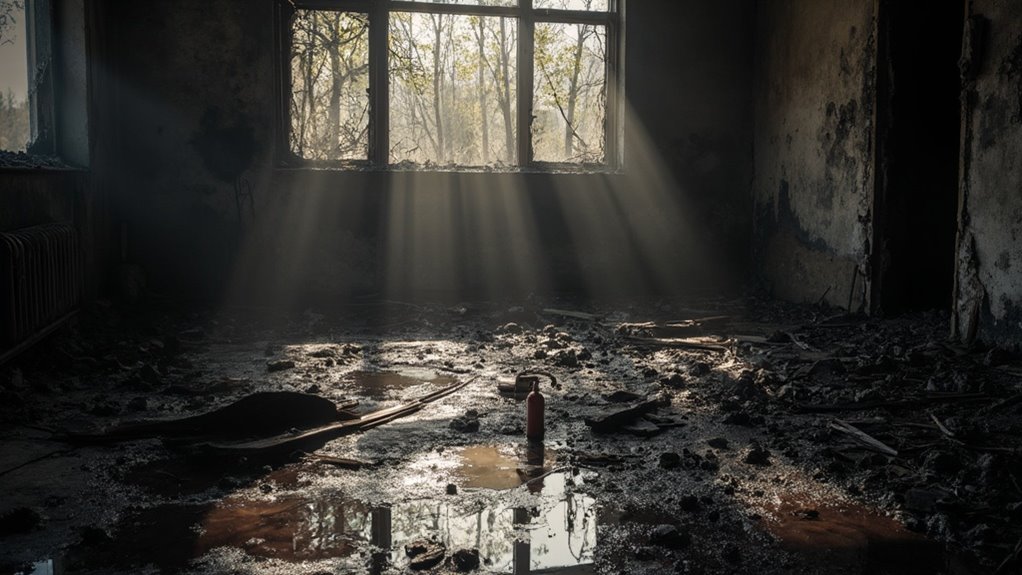
Water damage is often underestimated, yet its consequences can be devastating if neglected. After a fire, the risk of water damage increases considerably, and if you don't act quickly, you may face severe repercussions. Mold can start developing within 24 to 48 hours, so immediate action is essential for mold prevention and preserving your health.
Here are key considerations to keep in mind:
- Assess the Damage: Identify both visible and hidden water damage, including walls and HVAC systems.
- Utilize Moisture Detection: Employ specialized tools to locate hidden moisture that might not be immediately apparent.
- Turn Off Utilities: Prioritize safety by disconnecting electrical supply and wearing protective gear.
- Address Health Risks: Be aware that mold growth can lead to serious respiratory issues, particularly for vulnerable individuals.
- Implement Preventative Measures: Regular maintenance and quick repairs on plumbing and drainage systems can prevent future issues.
Disregarding Structural Integrity
After a fire, it's vital to assess any structural damage immediately, as signs of compromise can often be subtle yet severe. Ignoring these indicators can jeopardize your safety and the integrity of your building. Engaging professional inspections is fundamental to guarantee a thorough evaluation and safeguard against future risks.
Assessing Structural Damage
In the wake of fire damage, evaluating structural integrity is vital for guaranteeing safety and effective recovery. A thorough structural evaluation is fundamental to identify all damage, including hidden defects that could compromise safety and lead to costly repairs later. Engaging professionals for damage assessment guarantees you receive a detailed analysis.
Consider these key aspects during the assessment:
- Utilize both destructive and non-destructive testing methods for accurate results.
- Conduct visual inspections to compare damaged components with unaffected ones.
- Employ state-of-the-art cleaning techniques to remove soot, revealing underlying issues.
- Assess the temperature effects of the fire on various materials.
- Use advanced tools, like FARO 3-D laser scanners, for detailed imaging.
Signs of Compromise
While evaluating structural damage provides a foundation for safety, recognizing signs of compromise is similarly important for your well-being. Look for vital structural indicators that reveal the effects of fire intensity. If flames are visible through wall cracks, it signals increasing fire size and potential damage to structural members. New wall cracks during the incident can suggest active failure or movement within the building.
Pay attention to signs in the interior as well. Windows, doors, and floors that are out of level may indicate deeper structural issues, while sagging wooden floors often signify impending collapse. If you hear cracking noises, take them seriously; they can indicate structural failure.
Moreover, hidden damage can accumulate over time, heightening the risk of collapse. Previous fire incidents might have weakened the building's integrity, so don't ignore cosmetic repairs that hide deeper issues. Water damage, whether from firefighting efforts or hidden leaks, can lead to mold growth or further structural damage.
Being vigilant about these signs of compromise can protect both your safety and the integrity of your property. Trust your instincts; if something feels off, it's vital to act.
Professional Inspections Essential
Ignoring the need for professional inspections can leave you vulnerable to the hidden dangers that fire damage creates. Fire can severely compromise a building's structural integrity, making it vital to engage licensed structural engineers who possess the necessary professional credentials. They employ a variety of assessment methods to evaluate the extent of damage and guarantee safety.
Consider the following critical aspects of professional inspections:
- Immediate structural assessment to prevent further damage or collapse.
- Non-destructive and destructive testing of materials like concrete and wood.
- Use of advanced tools, such as FARO 3-D laser scanners for detailed imagery.
- Prioritization of repairs based on the severity of damage.
- Thorough assessment reports that aid insurance claims and legal proceedings.
Minimizing Fire Hazard Prevention
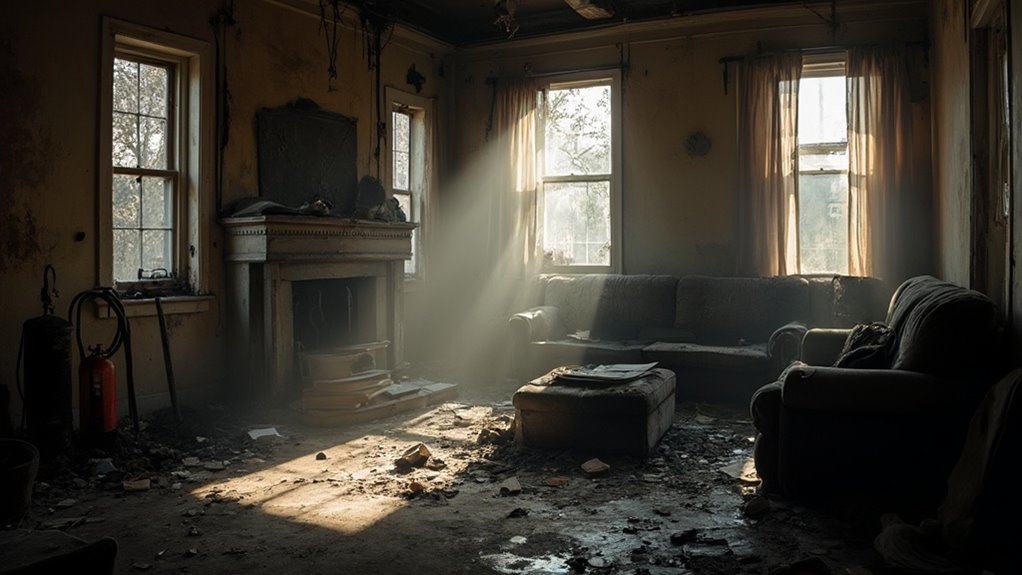
How can you effectively minimize fire hazards in your home? Start by implementing robust fire prevention strategies. Install smoke alarms on every level, including the basement and outside sleeping areas. Regular smoke alarm maintenance is essential; test these alarms monthly and replace batteries at least once a year.
Next, make certain fire extinguishers are easily accessible and regularly checked. Maintain a distance of no more than 100 feet between extinguishers in protected areas, guaranteeing they have a 2A rating for every 3,000 square feet.
In your kitchen, keep the area free of combustibles and use short or tight-fitting sleeves while cooking. Turn pot handles inward to prevent accidental spills, and enforce a strict "kid-free" zone around the stove.
Store flammable materials in designated areas away from heat sources and label them clearly. Avoid overloading electrical outlets, as this can lead to fires.
Lastly, always conduct thorough inspections for hidden hazards after any fire incident. Address any structural weaknesses and check for mold as a result of water damage. By following these steps, you'll cultivate a safer living environment for everyone.
Skipping Insurance Notifications
After experiencing fire damage, it's crucial not to overlook the importance of notifying your insurance company promptly. Your insurance policy likely requires "prompt notice" of any damages, and failing to do so can jeopardize your claim. Timely notification allows your insurer to investigate the damages, evaluate coverage, and provide immediate assistance, mitigating further issues.
Here are some best practices to follow when notifying your insurance company:
- Keep detailed records of all communications, including dates and names.
- Send a confirmation letter or email to acknowledge your notice.
- Report all visible damages and verify the property is safe before documenting.
- Notify both your insurance agent and the company directly, and obtain written confirmation of receipt.
- Thoroughly document the damage with photos and a list of losses before restoration begins.
Conclusion
In the aftermath of fire damage, it's vital to act swiftly and wisely. Remember, time's a-wasting when it comes to restoration. By avoiding common mistakes like DIY cleaning and neglecting safety, you can safeguard your home and well-being. Keep your insurance provider in the loop and prioritize thorough documentation. Taking these steps guarantees you're not only restoring your space but additionally preventing future issues. Don't let a disaster dictate your next moves; stay proactive for a smoother recovery.



